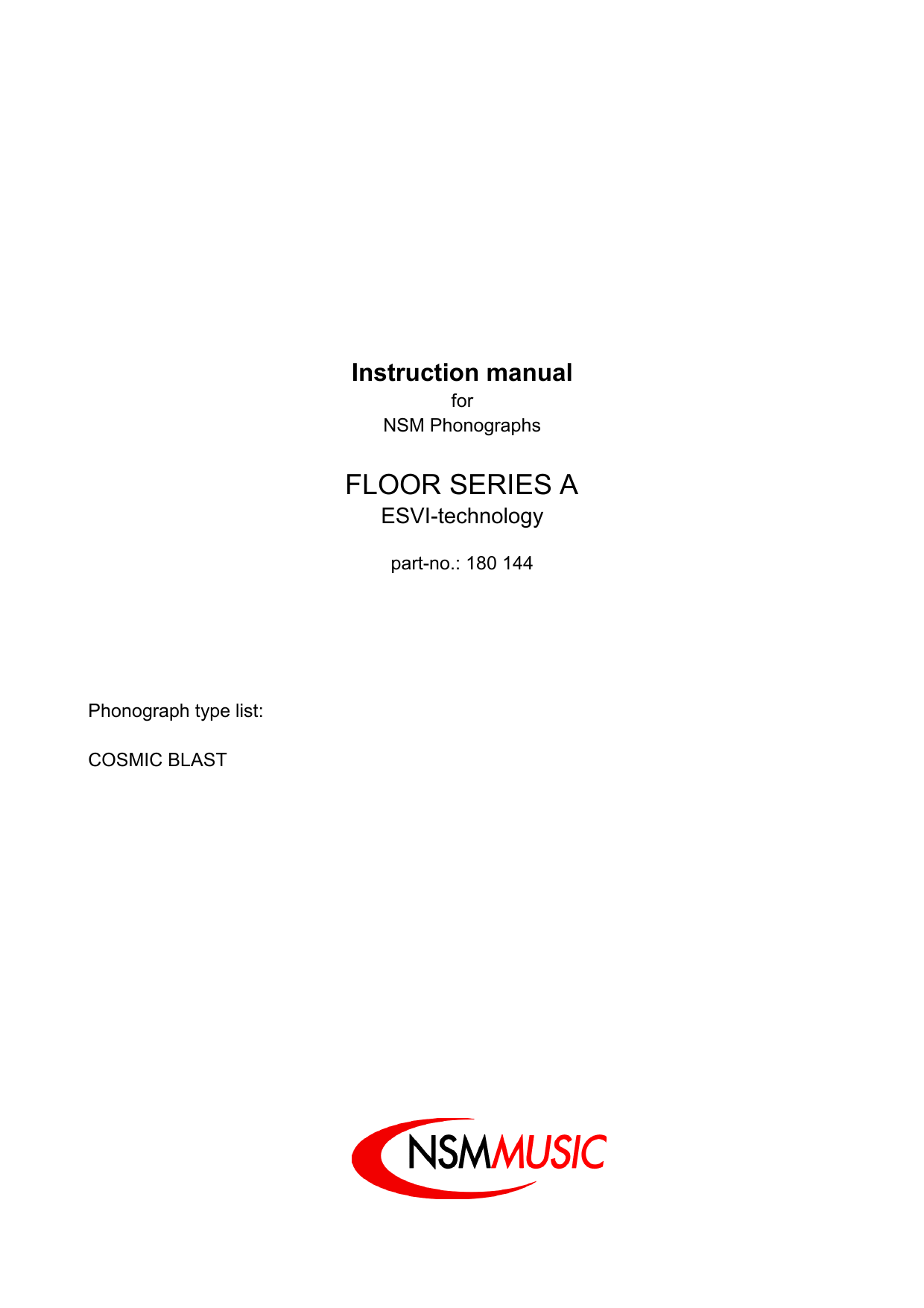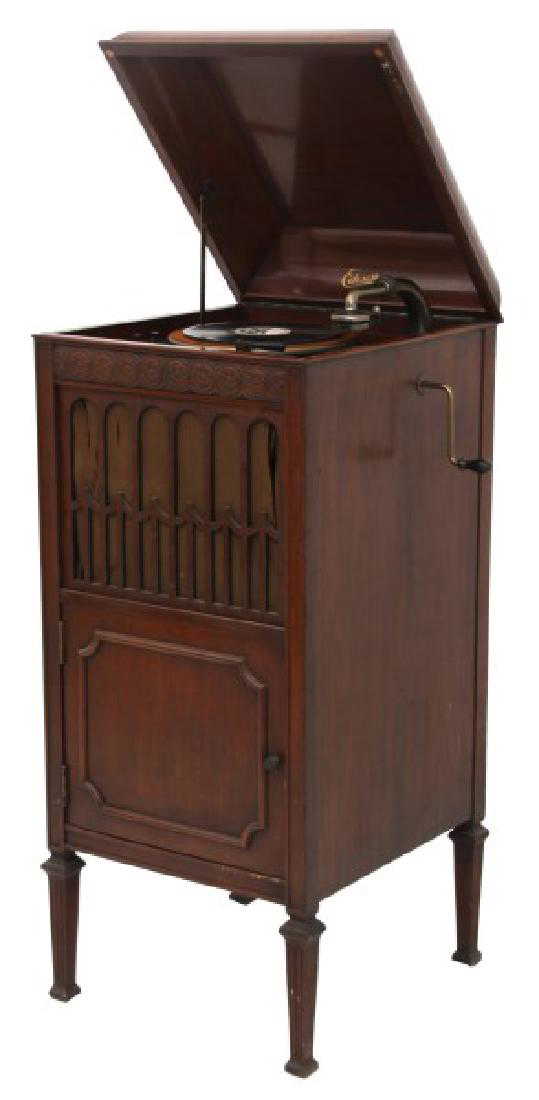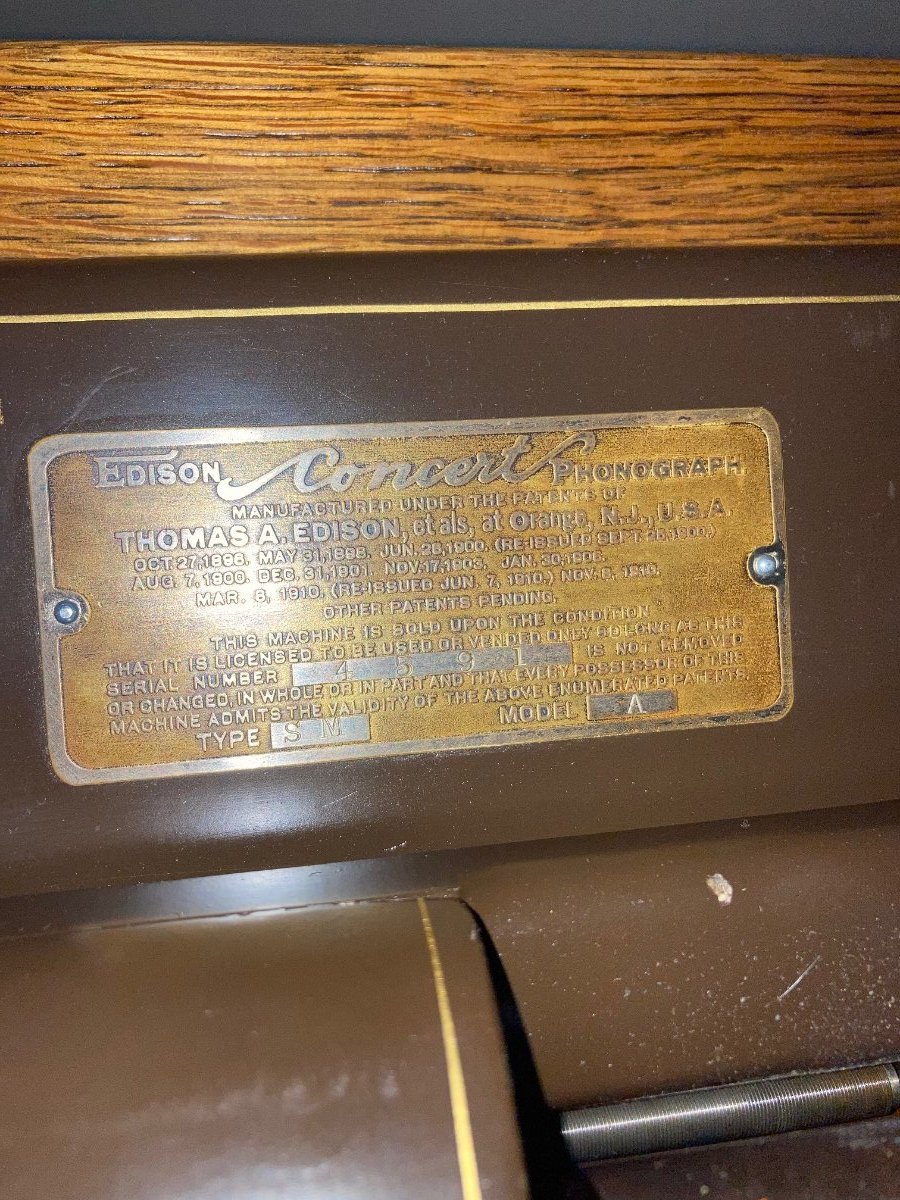A Brief History and Restoration Photos
Back to Home
Richard D. Densmore
We an have an Edison Disc Phonograph Serial # S-19- SM-86261 with 30 discs from the early 1900's. We cannot determine a value in Jax, FL. Expert's Assistant: I always love having an appraiser look at my stuff. Sometimes its turned out to be surprisingly valuable. FLOOR MODEL DISC PHONOGRAPH, Thomas A. Edison,FLOOR MODEL DISC PHONOGRAPH, Thomas A. Edison, Inc., model A-100, serial #SM43564, c. 1915-18, having a mahogany floor case with lift top, lattice speaker; EDISON C-250 CHIPPENDALE UPRIGHT CABINETEDISON C-250 CHIPPENDALE UPRIGHT CABINET PHONOGRAPH: Circa 1915-1919, Diamond Disc, serial number. The Diamond Disc phonograph was also the subject of one of the greatest campaigns in advertising history, beginning in earnest around 1915: the tone test demonstrations. A number of Edison vocal recording artists were trotted off to auditoriums around the country. Look hard for the 52,000 series. Sadly, changes came too late. When the last Edison records were issued in late 1929 (cylinders ceased with the June 1929 list), an era came to an end. I have to agree with Jim Walsh, a writer who is widely regarded as this century's authority on acoustic era recording artists. In a Nutshell Edison's top model phonograph, every collector's dream. Introduction: Edison's 'Opera' phonograph was introduced in November 1911, as the follow-up model to the 1907 2/4-minute combination model Idelia, from which it herited many details.It is a strictly 4-minute-only phonograph, that - after introduction of the Blue Amberol cylinders one year later - was sold.
Thomas Edison invented the phonograph in 1877. His first machine used grooved cylinders wrapped in tin foil, into which sound waves were etched. It wasn't until the 1890's that the first commercial recordings were available, wax cylinders issued by Edison and some other manufacturers, and the first disc recordings by the Berliner Company (a forerunner of Victor). Edison was a proponent of cylinder technology because of the uniform groove speed of cylinders. He also preferred his vertical (hill and dale) method of cutting the grooves as opposed to the lateral method used by Victor and most other companies. With the vertical method grooves were narrower and could be spaced more closely together, permitting longer recordings on a given surface area.
In spite of continuous improvement to his machines and cylinders, by 1910 Edison was the only major company still issuing cylinder recordings, and sales were falling. His competitors' disc records were less expensive to manufacture, they could be recorded on both sides (more music for your money), and were easier to store. Behind Mr. Edison's back, his engineers began work on a disc machine and records. Edison soon became enthusiastic. Two and a half years and three million dollars later, the Edison Diamond Disc phonograph was born. Introduced late in 1912, this machine was arguably the finest acoustic phonograph developed up to that time.
Edison Phonograph Serial Number List Free
The Edison Diamond Disc phonograph used a specially designed reproducer with a diamond stylus and a laminated rice paper diaphragm. The Edison disc player used a gear mechanism to advance the reproducer across the record, rather than forcing the record grooves to bear the weight of pulling the reproducer. This resulted in very little wear to the records, and reduced surface noise. The records were 10 inch diameter, quarter inch thick, vertical cut discs designed to play at 80rpm. These discs held up to five minutes of recorded sound on each side as compared to 3 minutes for the 78rpm records of other companies.
Edison disc records and phonographs were not compatible with other manufacturers' products. This eventually limited the company's ability to compete. In terms of the quality of sound reproduction, however, the Edison disc technology was far superior to that of other manufacturers, as the company demonstrated repeatedly through a series of public tone tests.
All recording during this time (1877- mid 1920's) was by the acoustical method. Singers or instrumentalists stood before a recording horn, which focused the sound waves to a recording diaphragm, connected to a stylus which cut the master wax disc. Edison was the acknowledged master of the art of acoustical recording.
The Diamond Disc phonograph was offered in a variety of models from late 1912 to 1927, and the records were sold until October 1929, when the company closed its doors, just days before the stock market crash. See my article Pipe Organ Artists and Recordings on the Edison Label for additional information on Edison phonographs and records.
In the year 1919 my Great Uncle, Mr. Leon Densmore of Perry, Ohio, purchased a brand new Model C19 (Chippendale) Edison Diamond Disc Phonograph, which was an upgrade of the earlier C-250 model. It cost $295, a substantial sum for that time. The C19 model had just been introduced that year and was known as 'the Official Laboratory Model.' This phonograph, quite deluxe for its time, featured in addition to the diamond stylus, a variable speed turntable, a volume control mechanism, a double spring motor, a 15' internal horn, and a cabinet to hold 72 records. During the next several years the Densmore family acquired a sizable collection of ten-inch Edison 'Re-Creations'. This collection included popular songs, fox-trots, waltzes, marches, character monologues, and other recordings which reflected the popular tastes of the time.

Leon Densmore moved to California in 1925, a trip that took him one month in a Model-T Ford. He necessarily left the Edison phonograph behind, and it remained in the Densmore family home for the next 52 years.
My first experiences with 'the Edison' came in the late 1950's (I was about five years old). My grandparents (Kenneth and Margaretta) and my Great Grandfather (Lester, the father of Leon and Kenneth) were living in the family home. Often when I visited them Great Grandpa would escort me to the room at the top of the stairs, which was then used for storage. He would raise the creaky lid of the Edison, wind it up, and play a few of his favorite records. I think he only had a few favorites (Margie, and Uncle Josh).
In 1961 my parents purchased the family home from my grandparents, and I became the proud owner of the Edison (I was the only member of the family willing to have it in my room). I grew up with the Edison, and it became my most prized possession. It gave me many hours of relaxation and happiness.
In 1977, I established my own residence and took the Edison with me. I began compiling a discography of my original collection of Edison Diamond Disc records. This became a complete listing for each record, with words to spoken and sung recordings, and indexes by title, performer, and composer/lyricist/author. This discography has gone into a second revised edition, plus a supplement to cover the other Edison discs that I have acquired in recent years.
In 1999, while doing additional reading on the Edison disc phonograph, I first became aware that in the 1920's, the Edison company began to issue recordings of (theatre) pipe organ music. As I am a church organist, this greatly intrigued me. I began to research the history of the organ records issued by the Edison company and also to collect these records. The results of my research can be read (see link to my organ record article above). This article has been published in the Spring 2001 issue of ARSC Journal (Association for Recorded Sound Collections). I own all 35 organ records that were issued by the Edison company: 34 diamond discs, plus the only Needle Type Electric (78rpm) organ record issued.
Edison Standard Phonograph Serial Number List

Today my Edison Diamond Disc phonograph is newly restored. See the Restoration section below. This wonderfully built machine still provides regular entertainment and enjoyment for the Densmore family.
(Note: the above pictures were all taken in the late 1970's when both the Edison and I were almost thirty years younger. The Edison now looks better than ever. I only look older!)RESTORATION OF MY EDISON C19 (CHIPPENDALE)
DIAMOND DISC PHONOGRAPH
(OFFICIAL LABORATORY MODEL)
In May of 2001 I decided to have my original Edison phonograph completely and professionally restored. Mr. Bob Laboda, of Hinckley, Ohio, had previously restored the reproducer, installing a new diamond stylus, as well as a new diaphragm and gaskets. Mr. Laboda cleaned, inspected, and re-calibrated the motor, mainsprings and mechanism. At the same time Mr. Duane Moses, owner of Family Furniture Refinishing of Strongsville, Ohio, completely restored and refinished the Edison cabinet, hand-stripped it, and used custom stains and high quality lacquers. From Mr. Wayne Holznagel of Mitchell, South Dakota I was able to acquire some missing brass pieces as well as some missing wood trim pieces which were incorporated into the restoration and made the Edison complete and original. Below are 'before' pictures taken a few days before I delivered the Edison to be restored.
#1
#2
#3
#4

The restoration process took four months and was completed in September of 2001. Below are pictures of my restored Edison. These pictures do not do justice to the beauty of the cabinet and the work done by Mr. Moses. Needless to say I am exceptionally pleased with how the Edison looks and plays.
#5
#6
#7
#8
#9

#10
A custom-made Dairy Queen ice cream cake, (Heath Bar flavored), designed by my son Ben, for my surprise 60th birthday party!
Last Updated on 10/28/2013
By Richard Densmore
Email: rdensmor@bw.edu